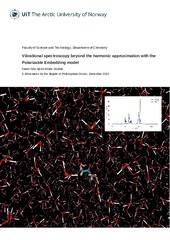| dc.contributor.advisor | Ruud, Kenneth | |
| dc.contributor.author | Dundas, Karen Oda Hjorth Minde | |
| dc.date.accessioned | 2021-02-12T09:27:05Z | |
| dc.date.available | 2021-02-12T09:27:05Z | |
| dc.date.issued | 2021-02-23 | |
| dc.description.abstract | In order to efficiently and accurately calculate vibrational properties for solvated systems, a theoretical framework for combining response theory with the Polarizable Embedding model (PE) has been derived and implemented, and is presented in this thesis.
An open-ended recursive formalism is utilized through the implementation in OpenRSP, allowing energy-derivatives to be calculated analytically up to arbitrary order.
In this way, errors associated with numerical differentiation are avoided, and calculations of properties of higher order can be performed without the need for additional implementation.
The PE model is a focused embedding model, and includes solvent effects through both static and instantaneous interaction energies between a central molecular region and a surrounding environment.
The central region is modelled using quantum-mechanical methods (and therefore is commonly referred to as the QM region), whereas the environment is treated through classical multipoles and polarizabilities.
The multipoles and polarizabilities are placed on so-called sites, typically located on the atoms in the environment.
This retains a discrete atomistic model while still considerably reducing the overall computational cost compared to a full quantum mechanical description.
The method allows the user to automatically calculate the multipoles and polarizabilities, thereby avoiding any need for using predetermined parameters.
In addition to its efficiency, the PE method is thus both accurate and flexible.
In this thesis, a new combination of the PE method with the open-ended response framework is presented, in addition to the implementation done in order to calculate various vibrational frequencies and intensities from the calculated energy derivatives.
The theoretical background for derivatives of the PE energy is outlined, and software for the calculation of these has been developed through a combination of the LSDalton, OpenRSP and FraME programs.
A new software package, SpectroscPy, has been developed in order to calculate spectroscopic frequencies and intensities, for either vacuous or solvated systems.
The current version of the program allows the user to produce IR, Raman and hyper-Raman spectra.
The implementation can be extended to better model repulsion interactions between the QM region and the environment through the Polarizable Density Embedding method.
Newer versions of the implementation should also contain the functionality necessary to perform calculations on biomolecules, as it for the moment only allows systems where no covalent bonds need to be cut in the partition of the QM region from the environment, and/or between the environmental fragments.
Once magnetic derivatives are available through OpenRSP, implementation of vibrational-rotational spectroscopic properties is also a route that should be investigated. | en_US |
| dc.description.doctoraltype | ph.d. | en_US |
| dc.description.popularabstract | Vibrational spectroscopic techniques are important for characterization of molecular structure. We can model the electronic potential in which the electrons move, either by a parabolic shape or a Morse potential. This gives us the harmonic and anharmonic properties, where the anharmonic is the most accurate, but also the most expensive, as it involves higher-order energy derivatives than the harmonic approximation.
In the theoretical study of properties, quantum mechanical (QM) approaches are used. However, as the size of the system increases, this becomes more and more computationally demanding and we can therefore choose to specifically focus on this part, describing it with a QM method, in the presence of its surroundings (modelled classically). The Polarizable Embedding model is one such model, which can be applied for a variety of systems. With this strategy, we are now able to model many chemically interesting systems, and their vibrational behaviour. | en_US |
| dc.description.sponsorship | Norwegian Research Council (grant nr. 250743 and 262695) | en_US |
| dc.identifier.uri | https://hdl.handle.net/10037/20569 | |
| dc.language.iso | eng | en_US |
| dc.publisher | UiT Norges arktiske universitet | en_US |
| dc.publisher | UiT The Arctic University of Norway | en_US |
| dc.relation.haspart | <p>Paper I: Dundas, K.O.H.M., Beerepoot, M.T.P., Ringholm, M., Reine, S., Bast, R., List, N.H., … Olsen, J.M.H. Harmonic Infrared and Raman Spectra in Molecular Environments using the Polarizable Embedding Model. (Submitted manuscript).
<p>Paper II: Dundas, K.O.H.M., Reine, S.S., Gao, B., Ruud, K., Olsen, J.M.H. & Ringholm, M. Analytic High-order Geometric Derivatives with Polarizable Embedding in a Response Theory Framework. (Manuscript).
<p>Paper III: Olsen, J.M.H., Reine, S.S., Vahtras, O., Kjellgren, E., Reinholdt, P., Dundas, K.O.H., … Norman, P. (2020). Dalton Project: A Python platform for molecular- and electronic-structure simulations of complex systems. <i>Journal of Chemical Physics, 152</i>(21), 214115. Also available in Munin at <a href=https://hdl.handle.net/10037/18566>https://hdl.handle.net/10037/18566</a>. | en_US |
| dc.relation.isbasedon | Dundas, K.O.H.M., Ringholm, M., Beerepoot, M.T.P. & Olsen, J.M.H. (2020). Dataset for the "Harmonic Infrared and Raman Spectra in Molecular Environments using the Polarizable Embedding Model" [Data set]. Zenodo. <a href=http://doi.org/10.5281/zenodo.4271303>http://doi.org/10.5281/zenodo.4271303</a> | en_US |
| dc.relation.isbasedon | Dundas, K.O.H.M., Ringholm, M. & Olsen, J.M.H. (2020). Dataset for "Analytic High-order Geometric Derivatives with Polarizable Embedding in a Response Function Framework" (Version 0.0.0) [Data set]. Zenodo. <a href=http://doi.org/10.5281/zenodo.4285811>http://doi.org/10.5281/zenodo.4285811</a>. | en_US |
| dc.relation.projectID | info:eu-repo/grantAgreement/RCN/FRINATEK/250743/Norway/New Dimensions in Theoretical Multiphoton Spectroscopy// | en_US |
| dc.relation.projectID | info:eu-repo/grantAgreement/RCN/SFF/262695/Norway/Hylleraas Centre for Quantum Molecular Sciences// | en_US |
| dc.rights.accessRights | openAccess | en_US |
| dc.rights.holder | Copyright 2021 The Author(s) | |
| dc.rights.uri | https://creativecommons.org/licenses/by-nc-sa/4.0 | en_US |
| dc.rights | Attribution-NonCommercial-ShareAlike 4.0 International (CC BY-NC-SA 4.0) | en_US |
| dc.subject | VDP::Mathematics and natural science: 400::Chemistry: 440::Theoretical chemistry, quantum chemistry: 444 | en_US |
| dc.subject | VDP::Matematikk og Naturvitenskap: 400::Kjemi: 440::Teoretisk kjemi, kvantekjemi: 444 | en_US |
| dc.title | Vibrational spectroscopy beyond the harmonic approximation with the Polarizable Embedding model | en_US |
| dc.type | Doctoral thesis | en_US |
| dc.type | Doktorgradsavhandling | en_US |


 English
English norsk
norsk
